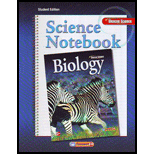
Concept explainers
To define:
The given terms using a book or a dictionary.
Introduction: Darwin gave a new theory of natural selection that could explain evolution of species. The theory of evolution states that all organisms on earth have a common ancestor. There are many evidences that suggest this; such as structural adaptations, fossil records, comparative anatomy, embryology, biochemistry, geographical distribution etc.
Explanation of Solution
Derived trait- Newly evolved features such as feathers that do not appear in the fossils of common ancestors are called derived traits.
Ancestral trait- This includes primitive features such as teeth and tails that do appear in the ancestral forms.
Homologous structures- Anatomically similar structures inherited from a common ancestor are called homologous structures.
Vestigial structure- These are structures that are the reduced forms of functional structures in other organisms.
Analogous structures- Functionally similar but structurally different structures not inherited from a common ancestor are called analogous structures.
Embryo- It refers to early stage of development of plant or animal.
Biogeography- It refers to the study of distribution of plants and animals on Earth.
Fitness- It refers to the count of offspring born to an individual with a trait compared to an individual without a trait.
Camouflage- An adaptation in which a species blends in with its environment is called camouflage.
Mimicry- An adaptation in which a species resembles other species is called mimicry.
Chapter 15 Solutions
Biology Science Notebook
Additional Science Textbook Solutions
Anatomy & Physiology (6th Edition)
Fundamentals of Anatomy & Physiology Plus Mastering A&P with eText - Access Card Package (10th Edition) (New A&P Titles by Ric Martini and Judi Nath)
Campbell Biology: Concepts & Connections (9th Edition)
Human Anatomy & Physiology (11th Edition)
Biological Science (6th Edition)
Microbiology with Diseases by Body System (5th Edition)
 Human Anatomy & Physiology (11th Edition)BiologyISBN:9780134580999Author:Elaine N. Marieb, Katja N. HoehnPublisher:PEARSON
Human Anatomy & Physiology (11th Edition)BiologyISBN:9780134580999Author:Elaine N. Marieb, Katja N. HoehnPublisher:PEARSON Biology 2eBiologyISBN:9781947172517Author:Matthew Douglas, Jung Choi, Mary Ann ClarkPublisher:OpenStax
Biology 2eBiologyISBN:9781947172517Author:Matthew Douglas, Jung Choi, Mary Ann ClarkPublisher:OpenStax Anatomy & PhysiologyBiologyISBN:9781259398629Author:McKinley, Michael P., O'loughlin, Valerie Dean, Bidle, Theresa StouterPublisher:Mcgraw Hill Education,
Anatomy & PhysiologyBiologyISBN:9781259398629Author:McKinley, Michael P., O'loughlin, Valerie Dean, Bidle, Theresa StouterPublisher:Mcgraw Hill Education, Molecular Biology of the Cell (Sixth Edition)BiologyISBN:9780815344322Author:Bruce Alberts, Alexander D. Johnson, Julian Lewis, David Morgan, Martin Raff, Keith Roberts, Peter WalterPublisher:W. W. Norton & Company
Molecular Biology of the Cell (Sixth Edition)BiologyISBN:9780815344322Author:Bruce Alberts, Alexander D. Johnson, Julian Lewis, David Morgan, Martin Raff, Keith Roberts, Peter WalterPublisher:W. W. Norton & Company Laboratory Manual For Human Anatomy & PhysiologyBiologyISBN:9781260159363Author:Martin, Terry R., Prentice-craver, CynthiaPublisher:McGraw-Hill Publishing Co.
Laboratory Manual For Human Anatomy & PhysiologyBiologyISBN:9781260159363Author:Martin, Terry R., Prentice-craver, CynthiaPublisher:McGraw-Hill Publishing Co. Inquiry Into Life (16th Edition)BiologyISBN:9781260231700Author:Sylvia S. Mader, Michael WindelspechtPublisher:McGraw Hill Education
Inquiry Into Life (16th Edition)BiologyISBN:9781260231700Author:Sylvia S. Mader, Michael WindelspechtPublisher:McGraw Hill Education





